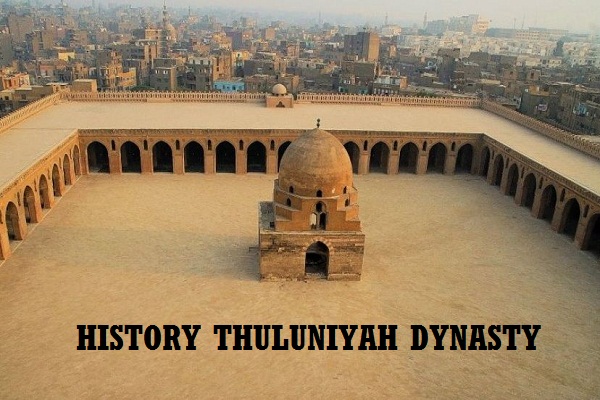HISTORY THULUNIYAH DYNASTY
1. A brief history of Thuluniyah
Thuluniyah is a dynasty that emerged and ruled in Egypt in the 9th century (3 H), namely from 868 AD (254 H) to 905 AD (292 H). Since 877 AD (263 H) this dynasty separated itself from the Caliphate of the Bani Abbas and thus Egypt for the first time after nine centuries, became an independent state (not a province or part of the Roman empire (30 BC-642 AD/21 H), Khilafah Khulafa al-Rashidin (642 AD/21 H-665 AD/40 H), the Umayyad Caliphate (665 AD/40 H-750 AD/132 H), and the Caliphate of Bani Abbas (750/132 H) until the Thuluniyah dynasty broke away from the Caliphate of Bini Abbas in 877 AD/263 H.
2. Establishment of the dynasty of Ibn Thulun
The founder/founder of the Thuluniyah dynasty was Ahmad bin Thulun, a man of Turkish blood. His father was sent along with other young men by the governor of Bukhara in Transoxiana as a gift to the Abbasid caliph, al-Ma’mun and he became a prominent man in the court.
His son, Ahmad, the future governor of Egypt, was taught Arabic, the Koran, and Islamic law in depth. He visited the borders of the Tarsus province several times to study under a special scholar until he became an expert in Islamic studies, as well as in the military arts which were taught to young Turks at that time. At first, he was sent from Baghdad to Egypt in 686 AD (254 H) to become deputy governor of Egypt. In 873 AD (259 AH) he broke away from the caliphate of the Bani Abbas and conquered Damascus, Homs, Homat, Aleppo, and Antioch (all in Sham and Syria).
Thus he not only made Egypt independent (stand-alone) but even ruled over the land of Sham, a situation that never happened after Egypt was conquered by the Persians in 340 BC. To facilitate efforts to control the land of Syria he built a strong navy and naval base in Akka (Sham).
Since breaking away from Banu Abbas, Ahmad bin Thulun never again sent a penny of Egyptian excise money to Baghdad. Egypt’s wealth is used for Egypt itself. he built the city of Qota’i to the north of Fustat, as the new capital, modeled after the city of Samarra, which was north of Baghdad. He built a big hospital.
The first hospital appeared in Egypt and he built a Great Mosque known as Jami ‘Ibn Thulun which on the inside was engraved approximately one-seventeenth of all the verses of the Koran in Kufic Arabic letters. He built many magnificent buildings to add to the splendor of the city which became a match for the city of Samarra.
3. The Progress of the Thaluniyah Dynasty
Ahmad bin Thlun’s attention to the economic sector is quite large. The size of the Nile River (nilometer) on the island of Raudah was repaired, dams and all irrigation were added, so that the agricultural area became wider, and industrial activities got strong motivation from it.
At that time there was a weapons industry, soap, sugar, cloth, and others. Bridges, canals, and land, river, and sea transportation fleets were enlarged for the sake of bustling and smooth trade traffic in all areas under their control. At the great mosque, special doctors are provided every Friday to treat the sick for free.
Likewise, he built several mustasyfa, namely public hospitals to accommodate patients of all religions and sects and receive free treatment until they are healthy. In short, after going through hard work, Ahmad ibn Thulun succeeded in realizing the prosperity and welfare of the people. In 904 AD (270 H) he died leaving a good name as a hafiz, a brave statesman, generous and close to the ulama and the people.
Furthermore, the Thuluniyah dynasty was led by his son, Khumarawaih who was only 20 years old. Soon the new amir was faced with a tough challenge. Damascus was attacked by a combined force (consisting of the forces of al-Muwaffiq, the brother of the caliph of Baghdad, the troops of Ibn Kindag, the governor of Mosul, and the troops of Muhammad bin Abi Sibag, the governor of Armenia). Amir Khumarawaih advanced to lead his troops to retake Damascus in 907 AD (273 H) and succeeded in forcing al-Muwaffiq and the Mu’tamid caliph to recognize the sovereignty of the Thuluniyah dynasty in Egypt and Syria. Khumarawaih’s power grew steadily and broadly after his main enemies died (al-Muwaffiq and Ibn Kindag in 912 AD (278 H) and the caliph Mu’tamid in the following year).
With abundant wealth, Khumarawaih rebuilt magnificent buildings and beautiful gardens. He used the money, among others, 900,000 dinars per year to finance troops and 23,000 dinars per month to provide free food for the poor and the weak through soup kitchens.
Within his majestic palace is the Golden Hall, a hall with walls covered in gold and decorated with pictures of his wives and pictures of court singers. The palace is located in the middle of a garden full of various flowers arranged in such a way as to form Arabic expressions. A silver-plated swimming pool in the palace courtyard, a zoo, and a bird palace complete the splendor of the Thuluniyah palace.
4. The decline of the Thuluniyah dynasty
Khumarawaih’s death in 895 AD (282 H) was the beginning of the dynasty’s decline. The intense rivalry between the elements of the dynastic authority has broken the unity within the dynasty. The third Amir, Abu al-Asakir bin Khumarawaih was opposed by some of his troops and was removed (896 AD/283 H). His younger brother, who was only 14 years old, Harun bin Khumarawaih, was appointed as the fourth Amir.
However, the weakness was such that the territory of Syria could be captured by the Qaramitah troops. The fifth Amir, Syaiban bin Ahmad bin Thulun, only ruled for 12 days, because he surrendered to the Bani Abbas troops who attacked Egypt in 905 AD (292 H), and thus ended the history of the Thuluniah dynasty.

